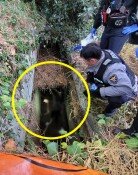[Opinion] The Korean Clawed Salamander
[Opinion] The Korean Clawed Salamander
Posted November. 29, 2004 23:15,
The salamander is a reptile residing in ponds, rice fields, and valleys deep within the mountains. The salamanders body length is around 7∼12cm, and it possesses a flat head, four front toes, and five toes on each of its hind legs. One New Years tradition involves fishing for frogs or salamanders eggs, as it was thought that hibernating animals that wake up and revive during the Gyungchip period (February 15 according to the moon calendar) are helpful for the body. The salamander also acts as a weather forecaster for farmers, as the animals fasten their eggs on rocks or branches during years in which heavy rain is predicted, while laying them in water in years of expected drought.
The Korean clawed salamander is named as such due to its tail that traces gracefully behind its somewhat shorter body. The Korean clawed salamander breathes through its skin, and is thus sensitive to the oxygen levels around its milieu. It resides in only the purest valley waters, where the water is cool and is shaded from the sun by the heavy groves. The salamanders gained their 15 minutes of fame due to the recent lawsuit, whereupon a number of environmental organizations set the Korean clawed salamander as the plaintiff and the Korea Railway Network as the defendant, in defiance of the Kyungbu KTX railway construction that pass through the Chunsung Mountains, its natural habitat.
There are 38 natural habitats of the Korean clawed salamanders, including the Whansun Cave of Samchuk, Gangwon Province, Naeri Valley of Hadong, Youngwol, Dukyu Mountain of North Cholla Province, and Chunsung Mountain of Yangsan, South Kyungnam Province, among others. The salamander was excluded from the endangered species list issued by the Ministry of Environment this August. A source in the Ministry of Environment reasoned that the salamander was not put on the list, as numerous habitats and a large number of the species have been found. Should the Korean clawed salamander, living in a large number of regions, be selected as an endangered species, salamander lawsuits that call for a halt to development projects are bound to arise nationwide.
Dissenting opinions have arisen, questioning whether it is really necessary to deplete governmental funds and inconvenience the citizens (and all that for salamanders!), as the Kyungbu Rail Network Construction Project which was spent 1.8 billion won had been detained for nine months. The Busan High Court of Justice has sided with the Korea Rail Network Authority, but the case was ultimately a win-win situation, as the environmental organizations managed to draw our attention to the environmental protection efforts as symbolized by the Korean clawed salamander. It now seems time to find a compromise of saving the wetlands of the Chun-seong Mountains and hence the Korean clawed salamanders, while at the same time allowing the Kyungbu KTX to pass through the area.
Hwang Ho-taek, Editorial writer, hthwang@donga.com







